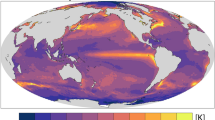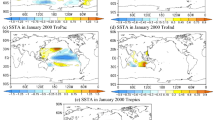Abstract
A study has been made, using the National Centers for Environmental Prediction and National Center for Atmospheric Research re-analysis 500 hPa geopotential height data, to determine how intraseasonal variability influences, or can generate, coherent patterns of interannual variability in the extratropical summer and winter Southern Hemisphere atmospheric circulation. In addition, by separating this intraseasonal component of interannual variability, we also consider how slowly varying external forcings and slowly varying (interannual and longer) internal dynamics might influence the interannual variability of the Southern Hemisphere circulation. This slow component of interannual variation is more likely to be potentially predictable. How sea surface temperatures are related to the slow components is also considered. The four dominant intraseasonal modes of interannual variability have horizontal structures similar to those seen in both well-known intraseasonal dynamical modes and statistical modes of intraseasonal variability. In particular, they reflect intraseasonal variability in the high latitudes associated with the Southern Annular Mode, and wavenumber 4 (summer) and wavenumber 3 (winter) patterns associated with south Pacific regions of persistent anomalies and blocking, and possibly variability related to the Madden-Julian Oscillation (MJO). The four dominant slow components of interannual variability, in both seasons, are related to high latitude variability associated with the Southern Annular Mode, El Nino Southern Oscillation (ENSO) variability, and South Pacific Wave variability associated with Indian Ocean SSTs. In both seasons, there are strong linear trends in the first slow mode of high latitude variability and these are shown to be related to similar trends in the Indian Ocean. Once these are taken into account there is no significant sea surface temperature forcing of these high latitude modes. The second and third ENSO related slow modes, in each season, have high correlations with tropical sea surface temperature variability in the Pacific and Indian Oceans, both contemporaneously and at one season lag. The fourth slow mode has a characteristic South Pacific wave structure of either a wavenumber 4 (summer) or wavenumber 3 (winter) pattern, with strongest loadings in the South Pacific sector, and an association simultaneously with a dipole SST temperature gradient in the subtropical Indian Ocean.












Similar content being viewed by others
References
Frederiksen JS (2002) Genesis of intraseasonal oscillations and equatorial waves. J Atmos Sci 59:2761–2781
Frederiksen CS, Balgovind RC (1994) The influence of the Indian Ocean/Indonesian SST gradient on the Australian winter rainfall and circulation in an atmospheric GCM. Quart J Roy Meteor Soc 120:923–952
Frederiksen JS, Frederiksen CS (1993a) Monsoon disturbances, intraseasonal oscillations, teleconnection patterns, blocking, and storm track of the global atmosphere during January 1979: linear theory. J Atmos Sci 50:1349–1372
Frederiksen JS, Frederiksen CS (1993b) Southern Hemisphere storm tracks, blocking and low-frequency anomalies in a primitive equation model. J Atmos Sci 50:3148–3163
Frederiksen CS, Frederiksen JS (1996) A theoretical model of Australian northwest cloudband disturbances and Southern Hemisphere storm tracks: the role of SST anomalies. J Atmos Sci 53:1410–1432
Frederiksen JS, Frederiksen CS (1997) Mechanisms of the formation of intraseasonal oscillations and Australian monsoon disturbances: the roles of latent heat, barotropic and baroclinic Instability. Contrib Atmos Phys 70:39–56
Frederiksen JS, Webster PJ (1988) Alternative theories of atmospheric teleconnections and low-frequency fluctuations. Rev Geophys 26:459–494
Frederiksen CS, Zheng X (2004) Variability of seasonal-mean fields arising from intraseasonal variability: Part 2, Application to NH winter circulations. Clim Dyn 23:193–206
Gillett NP, Thompson DWJ (2003) Simulation of recent Southern Hemisphere climate change. Science 296:895–899. DOI 10.1126/science, 1069270
Hoskins BJ, Karoly DJ (1981) The steady linear response of a spherical atmosphere to thermal and orographic forcing. J Atmos Sci 38:1179–1196
Kalnay EM et al (1996) The NCEP/NCAR 40-year reanalysis project. Bull Am Meteorol Soc 77:437–471
Karoly DJ (1989) Southern Hemisphere circulation features associated with El Nino-Southern Oscillation Events. J Clim 2:1239–1252
Karoly DJ, Plumb RA, Ting M (1989) Examples of the horizontal propagation of quasi-stationary waves. J Atmos Sci 46:2802–2811
Kidson JW (1988) Interannual variations in the Southern Hemisphere circulation. J Clim 1:1177–1198
Kidson JW (1999) Principal modes of Southern Hemisphere low-frequency variability obtained from NCEP-NCAR reanalyses. J Clim 12:2808–2830
Kiladis GN, Mo KC (1998) Interannual and intraseasonal variability in the Southern Hemisphere. Meteorology of the Southern Hemisphere, Meteor Monogr No. 49 Amer Meteor Soc pp 307–336
Kuo HL (1951) Dynamical aspects of the general circulation and stability of zonal flow. Tellus 3:268–284
Limpasuvan V, Hartmann DL (2000) Wave-maintained annular modes of climate variability. J Clim 7:1144–1163
Lorenz DJ, Hartmann DL (2001) Eddy-zonal flow feedback in the Southern Hemisphere. J Atmos Sci 58:3312–3327
Madden RA (1981) A quantitative approach to long-range prediction. J Geophys Res 86:9817–9825
Madden RA, Julian PR (1971) Detection of a 40–50 day oscillation in zonal wind in the tropical Pacific. J Atmos Sci 28:702–708
Mo KC (2000) Relationships between low-frequency variability in the Southern Hemisphere and sea surface temperature anomalies. J Clim 13:3599–3610
Mo KC, Ghil M (1987) Statistics and dynamics of persistent anomalies. J Atmos Sci 44:877–901
Mo KC, White GH (1985) Teleconnections in the Southern Hemisphere. Mon Wea Rev 113:22–37
Pan L-L, Jin F-F (2005) Seasonality of synoptic eddy feedback and the AO/NAO. Geophys Res Lett 32: L21708. DOI 10.1029/2005GL024133
Rayner NA, Parker DE, Folland CK, Alexander LV, Horton EB, Rowell DP (2003) Globally complete analyses of sea-surface temperature, sea-ice and marine air temperatrure, 1871–2000. J Geophys Res 180:4007. DOI 10.1029/2002JD002670
Renwick JA (1998) ENSO-related variability in the frequency of South Pacific Blocking. Mon Wea Rev 126:3117–3123
Renwick JA (2005) Persistent positive anomalies in the Southern Hemisphere circulation. Mon Wea Rev 133:977–988
Sinclair MR (1996) A climatology of anticyclones and blocking for the Southern Hemisphere. Mon Wea Rev 124:245–263
Speer K, Cassou C, Minvielle M (2006) Influence of Indian Ocean warming on the southern hemisphere: atmosphere and ocean circulation. In: Proceddings of 89 ICSHMO, Foz do Iguacu, Brazil, April 24–28, INPE, pp 455–461
Thompson DWJ, Solomon S (2002) Interpretation of recent Southern Hemisphere climate change. Science 296:895–899. DOI 10.1126/science, 1069270
Thompson DWJ, Wallace JM (2000) Annular modes in the extratropical circulation. Part I: month-to-month variability. J Clim 13:1000–1016
Vera C, Silvestri G, Barros V, Carril A (2004) Differences in El Nino response over The Southern Hemisphere. J Clim 17:1741–1752
Zheng X, Frederiksen CS (2004) Variability of seasonal-mean fields arising from intraseasonal variability: Part 1, Methodology. Clim Dyn 23:177–191
Zheng X, Frederiksen CS (2006) A study of predictable patterns for seasonal forecasting of New Zealand rainfall. J Clim 19:3320–3333
Zheng X, Nakamura H, Renwick JA (2000) Potential predictability of seasonal means based on monthly time series of meteorological variables. J Clim 13:2591–2604
Zheng X, Sugi M, Frederiksen CS (2004) Interannual variability and predictability in an ensemble of climate simulations with the MRI-JMA AGCM. J Meteor Soc Jpn 82:1–18
Acknowledgments
This work was supported by the New Zealand Foundation for Research, Science and Technology (contract C01X0202). We wish to thank BMRC for funding several visiting fellowships for XZ. Thanks also to Dr Hisashi Nakamura and two anonymous reviewers for their very useful comments on an earlier draft of this paper.
Author information
Authors and Affiliations
Corresponding author
Rights and permissions
About this article
Cite this article
Frederiksen, C.S., Zheng, X. Variability of seasonal-mean fields arising from intraseasonal variability. Part 3: Application to SH winter and summer circulations. Clim Dyn 28, 849–866 (2007). https://doi.org/10.1007/s00382-006-0214-9
Received:
Accepted:
Published:
Issue Date:
DOI: https://doi.org/10.1007/s00382-006-0214-9




